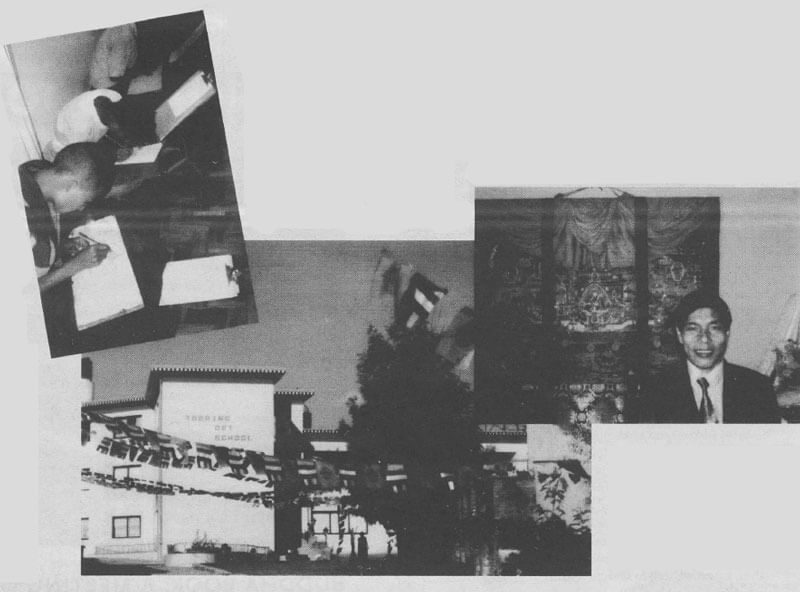| The following article is from the Summer, 1998 issue of the Snow Lion Newsletter and is for historical reference only. You can see this in context of the original newsletter here. |
The Shechen Institute for Traditional Tibetan Arts is a three-storied building located on the grounds of Shechen Monastery in Baudha, Nepal. It is dedicated to the preservation of Tibetan sacred arts and includes the Tsering Art School, an archive facility, workshops for the manufacture of incense, and studios for carving wood masks and making costumes for sacred dances. It was built under the direction of Shechen Rabjam Rinpoche with the generous support of the Dutch Government and a private donor. The goal of the Art School is to train a new generation of men and women from the Himalayan region and from Western countries in the authentic tradition of Tibetan Buddhist painting.
In Tibet, the only form of painting was sacred art thangkas (scrolls) and wall frescoes with Buddhist themes most of which was housed in monasteries and temples. Tibetan thangkas are not merely works of art, but are means to convey information of iconography and lineage that is essential for a Buddhist practitioner. Accuracy as well as beauty of execution is of utmost importance. During the 1960s the ancient traditional arts suffered irreparable damage when over 6,000 monasteries and the artwork they contained were destroyed in the Chinese Cultural Revolution.
In the last few years a number of artist studios have opened in the Kathmandu Valley to produce thangkas for tourists. Unfortunately, many of these artists have not had the opportunity to learn traditional painting methods and proper proportions, and most of the new thangkas flooding the market have incorrect iconography and are poorly executed. The tradition of Tibetan thangka painting is degenerating and in imminent danger.
The School's dean and painting teacher is Konchok Lhadrepa, one of the best trained and most experienced thangka painters alive today. He is among the last authentic holders of the Karma Gadri School of painting which prevailed in Eastern Tibet. It is characterized by its use of spacious landscape, transparent hues, and a unique elegance combined with minute attention to details.
When Konchok was ten years old he first met Dilgo Khyentse Rinpoche, from whom he acquired most of his vast knowledge. Over the years, he painted many works for Rinpoche who in turn advised him on the correct expressions, proportions and the details of iconography. Under Rinpoche's careful supervision, Konchok painted the frescoes in Shechen Monastery, Nepal, that span three long walls of the temple.
The Tsering Art School provides an opportunity for this precious and rare oral tradition to be passed on to others during Konchok's lifetime. The full course is six years, with an exception made for foreign students who may study as day students on a short term basis. There are already three Western students enrolled in the school.
The first year is devoted to learning the techniques of proportion and drawing and the use of paints and colors. During the next four years, the students study the detailed iconography of different figures and work on specific projects. In the sixth year, they learn to draw and paint mandalas and write sacred script.
The student body is drawn from the young monks of Shechen Monastery, and lay men and women from the local community and Western countries. A maximum of twenty-five students will be accepted in order to enable individual training. The school would like to train women artists who have not been given a chance to learn this skill in the past. There are currently three women students enrolled (two Westerners and one Nepali). The School is not run on a commercial basis, but it will accept commissions from individuals and centers. In the future, courses on silk thangka weaving will be added to the curriculum. Shechen has a weaver skilled in this craft who has consented to teach this rare traditional art form.
To further preserve the tradition of sacred arts, Shechen's archive facility safely houses a rare collection of 13,000 color slides and negatives of Tibetan miniature paintings, thangkas and statues. The archives also contain photographs and negatives of Dilgo Khyentse Rinpoche and other teachers, a collection of rare texts, and both audio and visual records of Buddhist teachings. All these are stored in a climate controlled room. In the archive office itself, rare works and photographs are scanned and preserved on CDs.
On December 6, 1997, under a clear blue Nepali sky, the inaugural ceremonies began for the newly constructed building. A large audience of Buddhist teachers, guests, dignitaries, and friends gathered to hear the keynote address by Matthieu Ricard and speeches by Thomas Derksen, the Honorary Dutch Consul in Nepal and Gerold Muller of the European Commission. The guests toured the building to see a photography exhibition of works by Matthieu Ricard and other photographers rare black and white photographs of Khyentse Rinpoche, delightful photos of Rabjam Rinpoche as a young boy, brilliant scenes of Tibet and sacred dancers. Many of the large black and white prints were created from tattered old photographs that had been preserved and reprinted in the new Shechen archive facility.
To learn more about the Tsering Art School, visit their webpage.

Left:Students at work Middle: The Tsering Art School building Above: Konchok Lhadrepa, master thangka painter and dean of the Tsering Art. School
(All photos by Vivian Kurtz)

